|
The Wheatfield Battle
of Gettysburg
The Wheatfield and Battle of Gettysburg
Summary
Gen. Robert E. Lee concentrated his full strength against Maj. Gen. George G. Meade’s Army of the
Potomac at the crossroads county seat of Gettysburg at what would come to be known as the Battle of Gettysburg. On July 1,
Confederate forces converged on the town from west and north, driving Union defenders back through the streets to Cemetery
Hill. During the night, reinforcements arrived for both sides. On July 2, Lee attempted to envelop the Federals, first striking
the Union left flank at the Peach Orchard, Wheatfield, Devil’s Den, and the Round Tops with Longstreet’s and Hill’s
divisions, and then attacking the Union right at Culp’s and East Cemetery Hills with Ewell’s divisions.
By evening, the Federals retained Little Round Top and had repulsed most of Ewell’s men. During the
morning of July 3, the Confederate infantry were driven from their last toe-hold on Culp’s Hill. In the afternoon, after
a preliminary artillery bombardment, Lee attacked the Union center on Cemetery Ridge. The Pickett-Pettigrew assault (more
popularly, Pickett’s Charge) momentarily pierced the Union line but was driven back with severe casualties. Stuart’s
cavalry attempted to gain the Union rear but was repulsed. On July 4, Lee began withdrawing his army toward Williamsport on
the Potomac River, thus concluding the Battle of Gettysburg. His train of wounded stretched more than fourteen miles.
| Aerial view of George Rose's wheatfield |
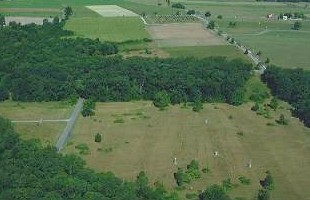
|
| Gettysburg NMP |
History
The second day’s battle of Gettysburg was the largest and costliest
of the three days. The second day’s fighting (at Devil’s Den, Little Round Top, The Wheatfield, The Peach Orchard,
Cemetery Ridge, Trostle Farm, Culp’s Hill and Cemetery Hill) involved at least 100,000 soldiers of which roughly 20,000
were killed, wounded, captured or missing. The second day in itself ranks as the 10th bloodiest battle of the Civil War.
Charge and counter charge on the afternoon of July 2 left this field and nearby woods strewn with more than
4,000 dead and wounded Union and Confederate soldiers. Thousands of troops fought in this area and veterans compared it to
a whirlpool- a stream of eddies and tides that flowed around the 19 acres of wheat owned by farmer George Rose, that changed
hands six times. This aerial view of the field is toward the west with the Peach Orchard at the central top. The woods that border the field were not as dense in 1863 as they are today, but they
did provide cover for the Confederates as they maneuvered around Union positions here.
Fighting began in earnest around 4:30 when a Georgia Brigade commanded by Brig. General George Anderson
swept through the woods to the south and ran into Brig. General Regis deTrobriand's Union regiments stationed behind a stone
wall on the southern end of the field. Some of deTrobriand's regiments had been peeled off to support the positions at Devil's Den, and though he was outnumbered by Anderson's larger regiments, his remaining soldiers kept the Confederates
at bay for nearly an hour.
| Battle of The Wheatfield, Gettysburg |
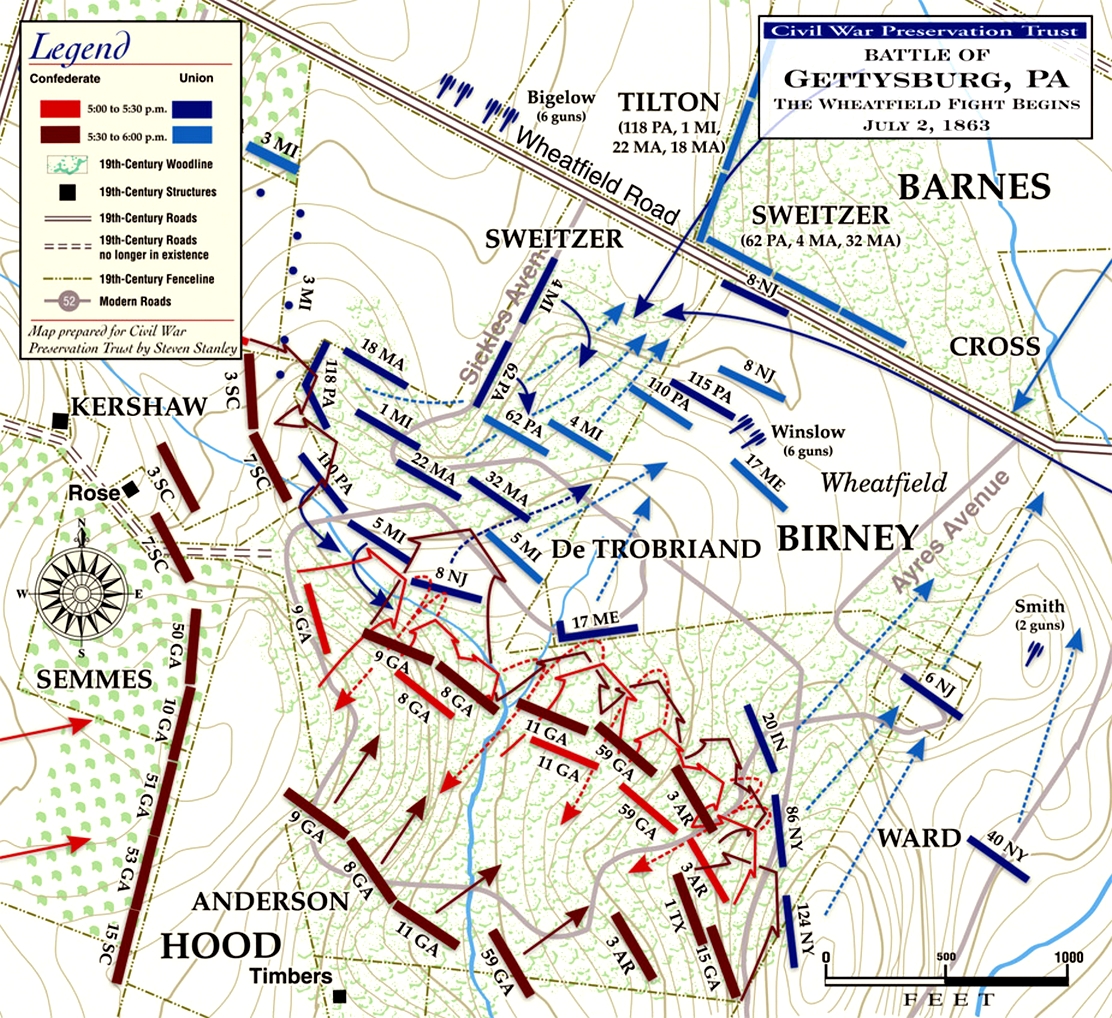
|
| Battle of The Wheatfield, Gettysburg, July 2, 1863 |
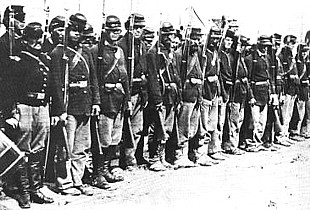
(Right) Picture of soldiers who fought in the Wheatfield, a platoon of the
110th Pennsylvania Volunteer Infantry. National Archives.
Anderson skillfully maneuvered his soldiers in front of the Union troops, conserving ammunition and manpower,
while the overtaxed Northerners stubbornly held their position. Re-enforcements were desperately needed as ammunition ran
out. DeTrobriand's 17th Maine Infantry had used up all of their ammunition and ordered to withdraw, the regiment backed through
the Wheatfield closely followed by Anderson's men who triumphantly swarmed over the wall. General David Birney, commanding
this section of the line, ordered the 17th Maine to about face and led them in a desperate bayonet charge. Birney's counterattack
temporarily swept Anderson's men from the field, but the Southerners were not to be denied. Rallied by their officers, the
Georgians renewed their attack as Union re-enforcements marched onto the scene.
| The Wheatfield |
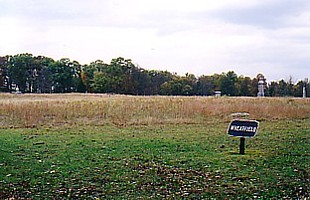
|
| Gettysburg NMP |
As the fighting raged in the southern end of the Wheatfield, Union troops filtered into the woods to the
east and west to slug it out with Confederates moving in from the direction of the Rose Farm. General Kershaw's Brigade of South Carolina soldiers crossed the Rose Farm and attacked Union troops on a small rocky knoll that borders
the west side of the field. The fighting swelled to a crescendo and raged steadily for a hour, when the Union troops began
to pull out.
The famous Irish Brigade arrived and tramped through the Wheatfield to, in turn, push the Confederates off the knoll. A determined Kershaw
threw his men back into the attack, re-enforced with a Georgia Brigade under Brig. General Paul Semmes. Semmes led two of
his regiments into a gap on Kershaw's right in the lower part of the Wheatfield, where he was seriously wounded and his men
counterattacked by a fresh Union brigade under Colonel John Brooke. At the point of the bayonet, Brooke's small regiments
drove Semmes' men back to the Rose Farm orchards south of the house and the two sides fought it out in a see-saw struggle.
Southern pressure was relentless and the Union forces began to withdraw from the Wheatfield and surrounding
woods. The fighting was close and, for a time, hand to hand. Colonel Harrison Jeffords of the 4th Michigan Infantry was bayoneted
by a Confederate soldier as he rushed to save the flag of his regiment from capture. Finally, Brig. General Wofford's brigade
swept the field and all was quiet except for the groans of the thousands of wounded and dying. George Rose's Wheatfield is
truly one of the bloodiest sites on the battlefield.
| Battle of The Wheatfield, Gettysburg |
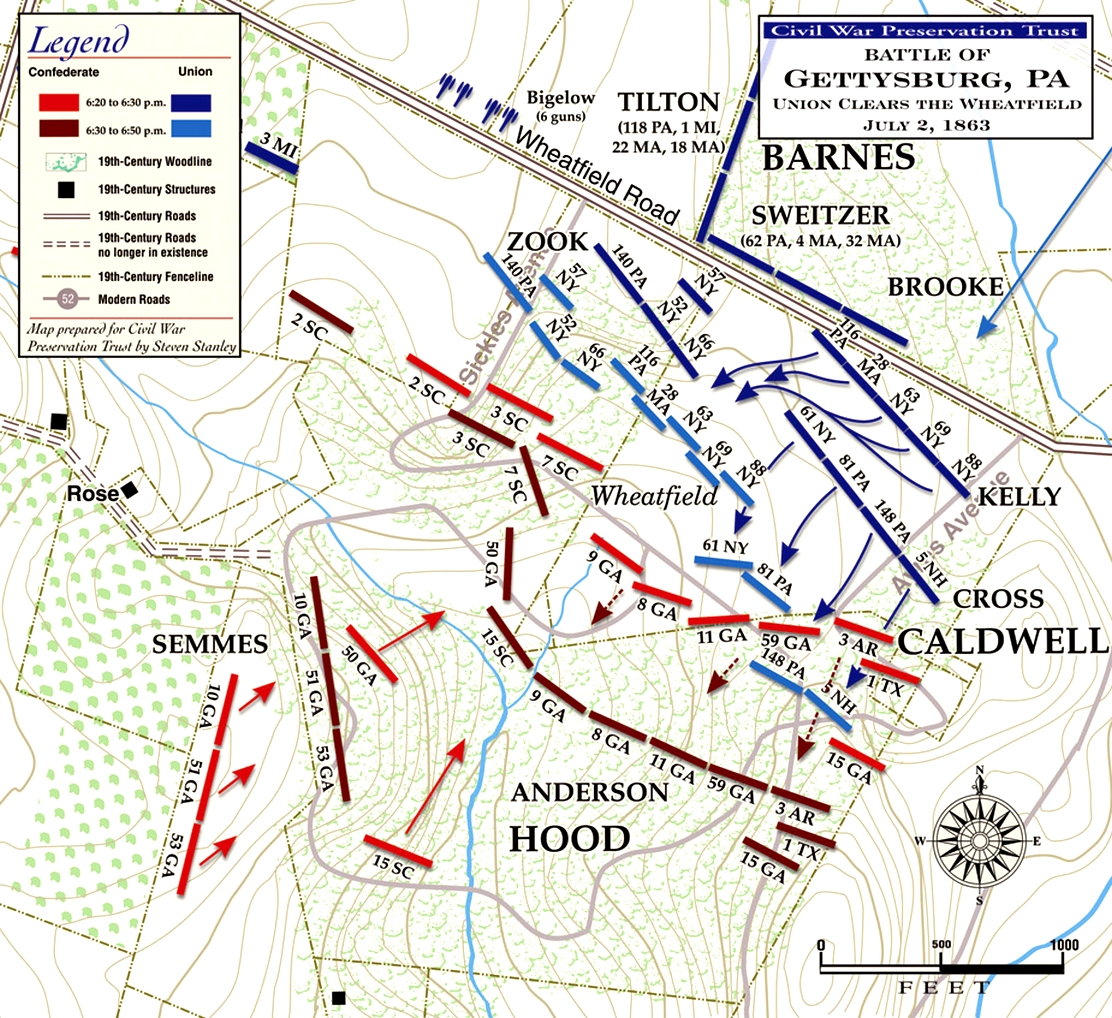
|
| Battle of The Wheatfield, Gettysburg, July 2, 1863 |
Analysis
By 5:30 p.m., when the first of Kershaw's regiments neared the Rose farmhouse,
Stony Hill had been reinforced by two brigades of the 1st Division, V Corps, under Brig. Gen. James Barnes, those of Cols.
William S. Tilton and Jacob B. Sweitzer. Kershaw's men placed great pressure on the 17th Maine, but it continued to hold.
For some reason, however, Barnes withdrew his understrength division about 300 yards to the north—without consultation
with Birney's men—to a new position near the Wheatfield Road. Trobriand and the 17th Maine had to follow suit, and the
Confederates seized Stony Hill and streamed into the Wheatfield. (Barnes's controversial decision was widely criticized after
the battle, and it effectively ended his military career.)
Earlier that afternoon, as Meade realized the folly of Sickles's movement,
he ordered Hancock to send a division from the II Corps to reinforce the III Corps. Hancock sent the 1st Division under Brig.
Gen. John C. Caldwell from its reserve position behind Cemetery Ridge. It arrived at about 6 p.m. and three brigades, under
Cols. Samuel K. Zook, Patrick Kelly (the Irish Brigade), and Edward E. Cross moved forward; the fourth brigade, under Col.
John R. Brooke, was in reserve. Zook and Kelly drove the Confederates from Stony Hill, and Cross cleared the Wheatfield, pushing
Kershaw's men back to the edge of Rose Woods. Both Zook and Cross were mortally wounded in leading their brigades through
these assaults, as was Confederate Semmes. When Cross's men had exhausted their ammunition, Caldwell ordered Brooke to relieve
them. By this time, however, the Union position in the Peach Orchard had collapsed, and Wofford's assault continued down the
Wheatfield Road, taking Stony Hill and flanking the Union forces in the Wheatfield.
Brooke's brigade in Rose Woods had to retreat in some disorder. Sweitzer's
brigade was sent in to delay the Confederate assault, and they did this effectively in vicious hand-to-hand combat. The Wheatfield
changed hands once again.
| Battle of The Wheatfield, Gettysburg |
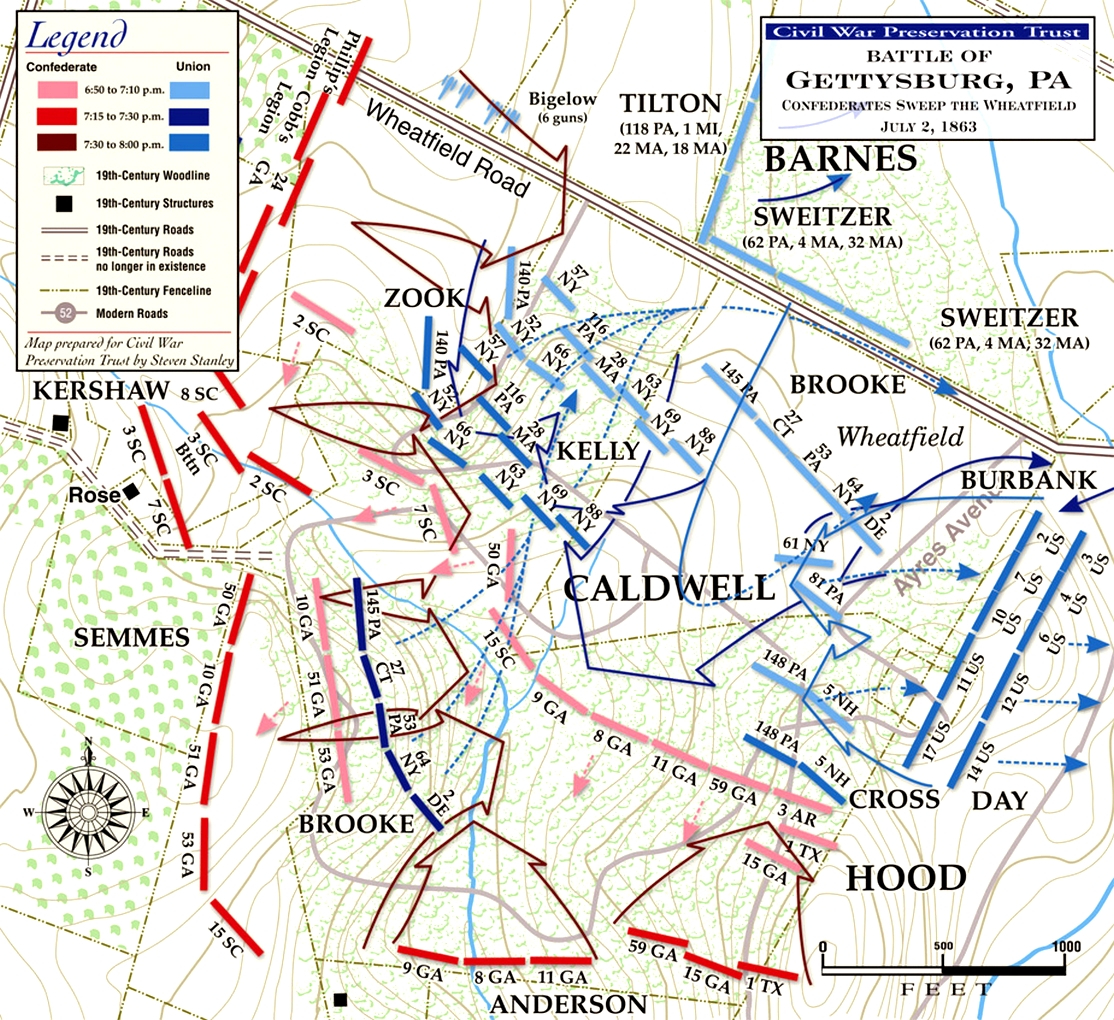
|
| Battle of The Wheatfield, Gettysburg, July 2, 1863 |
Additional Union troops had arrived by this time. The 2nd Division of the
V corps, under Brig. Gen. Romeyn B. Ayres, was known as the "Regular Division" because two of its three brigades were composed
entirely of U.S. Army (regular army) troops, not state volunteers. (The brigade of volunteers, under Brig. Gen. Stephen H.
Weed, was already engaged on Little Round Top, so only the regular army brigades arrived at the Wheatfield.) In their advance
across the Valley of Death they had come under heavy fire from Confederate sharpshooters in Devil's Den. As the regulars advanced,
the Confederates swarmed over Stony Hill and through Rose Woods, flanking the newly arrived brigades. The regulars retreated
back to the relative safety of Little Round Top in good order, despite taking heavy casualties and pursuing Confederates.
The two regular brigades suffered 829 casualties out of 2,613 engaged.
This final Confederate assault through the Wheatfield continued past Houck's
Ridge into the Valley of Death at about 7:30 p.m. The brigades of Anderson, Semmes, and Kershaw were exhausted from hours
of combat in the summer heat and advanced east with units jumbled up together. Wofford's brigade followed to the left along
the Wheatfield Road. As they reached the northern shoulder of Little Round Top, they were met with a counterattack from the
3rd Division (the Pennsylvania Reserves) of the V Corps, under Brig. Gen. Samuel W. Crawford. The brigade of Col. William
McCandless, including a company from the Gettysburg area, spearheaded the attack and drove the exhausted Confederates back
beyond the Wheatfield to Stony Hill. Realizing that his troops were too far advanced and exposed, Crawford pulled the brigade
back to the east edge of the Wheatfield.
The bloody Wheatfield remained quiet for the rest of the battle. But it
took a heavy toll on the men who traded possession back-and-forth. The Confederates had fought six brigades against 13 (somewhat
smaller) Federal brigades, and of the 20,444 men engaged, about 30% were casualties. Some of the wounded managed to crawl
to Plum Run but could not cross it. The river ran red with their blood. As with the Cornfield at Antietam, this small expanse
of agricultural ground would be remembered by veterans as a name of unique significance in the history of warfare.
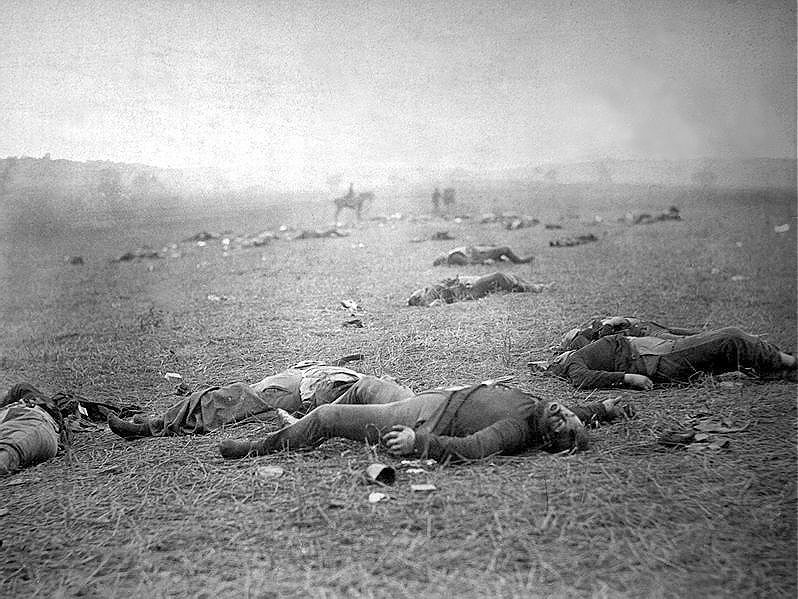
|
| Civil War Dead at Gettysburg |
(About) "Harvest of death," photograph by Timothy O'Sullivan of Union dead. Although
this is one of the most circulated photographs of Civil War dead, Frassanito, pp. 315-18, states that the location of where
this photograph (his plate "104b") was taken is unknown, but he groups it with others near the Rose Farm and confirms that
the dead are Union. Library of Congress.
| Gen. Semmes |

|
| Blue & Gray |
| Gen. Zook |

|
| Battles & Leaders |
Two generals were mortally wounded during the severe contest in the Wheatfield. Shot in the leg as he led
his troops toward the Wheatfield, Brig. General Paul Semmes was carried back to a field hospital that night. Weak and pale
from loss of blood, Confederate surgeons did all they could to save the general's life. After treatment by the surgeons, the
general was taken by ambulance to Martinsburg, West Virginia for further medical care and he appeared to be improving. Then
an unstoppable infection set in and there was little the doctors could do to stop it. Semmes lingered in great pain until
his death on July 10. The blood-stained uniform coat the general wore at Gettysburg is preserved in the collection of the
Museum of the Confederacy in Richmond, Virginia.
Like General Semmes, Brig. General Samuel Kosciuszko Zook was wounded as he led his brigade into action
to engage Confederates in the woods on the west side of the Wheatfield. Born in Pennsylvania and raised near Valley Forge,
the charismatic officer commanded one of four brigades from the Second Corps that were rushed to the scene that afternoon.
To get his regiments into the field, General Zook ordered his soldiers to march over a prostrate line of disorganized Union
soldiers and had ridden ahead of his men when he was struck in the abdomen by a Confederate bullet. Aides carried the general
to an ambulance that transported him to a Union field hospital on the Baltimore Pike. Here, surgeons pronounced the wound
mortal and the general died soon after midnight. General Zook is buried in Norristown, Pennsylvania.
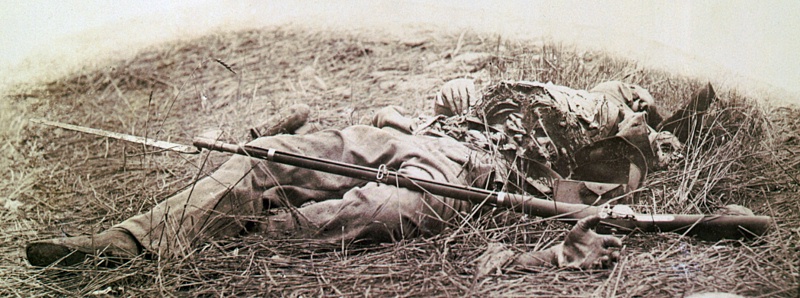
|
| Library of Congress |
(About) A Union soldier killed by a shell in "the Wheatfield" at Gettysburg, July 3, 1863. His
arm is torn off and the shell completely disemboweled him.
| Irish Brigade Monument |
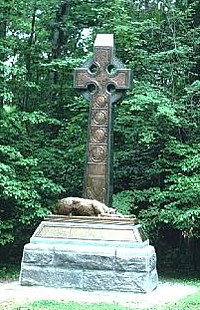
|
| Gettysburg NMP |
Set in the woods adjacent to the Wheatfield is one of the park's more
impressive and memorable monuments dedicated to the memory of the three New York regiments of the "Irish Brigade", raised from the Irish population of New York City. Many of the soldiers in these celebrated regiments were
immigrants who had come to the United States to escape political repression and the "Potato Famine" of the 1850's when thousands
starved to death. The brigade was the brainchild of Thomas Francis Meagher, an Irish-born
transplant and ambitious activist who began the war as a captain in the 69th New York Militia. Meagher returned to New York
from the battlefield of First Bull Run, obsessed with organizing an entire brigade of Irish regiments. Over 2,500 Irish soldiers
were recruited to fill the ranks of the 63rd, 69th, and 88th New York Infantry Regiments of the new brigade, which was later
joined by the 28th Massachusetts Infantry. Appointed brigadier general in 1862 and given command of the brigade, Meagher drilled
his regiments in the defenses of Washington before they were sent to join the Army of the Potomac. The brigade fought with great distinction and great gallantry during the Peninsula Campaign (aka Peninsular Campaign), Antietam, and at Fredericksburg where the brigade suffered high casualties
in the attack against fortified Confederate positions. By the opening of the Gettysburg campaign, the brigade, including the
116th Pennsylvania Infantry, barely mustered 530 men; 198 became casualties during the battle within these woods.
In 1888, a handful of veterans
returned to Gettysburg to dedicate their monument of green granite topped by a Celtic cross and adorned with the likeness
of an Irish Wolfhound, the traditional Irish symbol of loyalty. The work of sculptor Rudolph O'Donovan, it is one of the more
unique monuments in the battlefield park.
"Of those who in their manhood died to blot out Slavery's
stain,
And rear aloft in all its pride, fair Freedom's flag again!
'Tis ours to raise this cross on high above the Irish
dead,
Who showed mankind the way to die, when Truth and Freedom led."
-from Our Fallen Comrades, by William Collins, 1888.
Sources: National Park Service; Gettysburg National Military Park; Civil
War Trust.
Recommended Reading: Gettysburg’s Bloody Wheatfield. Review: The fight for the Wheatfield at Gettysburg on July 2, 1863, has long been one of the most confusing
and misunderstood engagements of that famous battle... until now. Gettysburg’s
Bloody Wheatfield provides readers with a definitive history of the fight where one out of every three soldiers was a
casualty. This book is the Winner of the Bachelder-Coddington Award for 2002 for the book on Gettysburg that provides the best new information about the battle! Continued below…
About
the Author: Jay Jorgensen earned a bachelor’s degree in history from Fairleigh
Dickinson University and received
his juris doctorate from Villanova University School of Law. He has a Master of Arts degree in military history and
Civil War studies from American Military
University. He is a partner in the law firm of Jorgensen & Barnes
and also serves as a municipal court judge in New Jersey.
Jay is a frequent presenter at Civil War Round Tables and has had six articles published in Gettysburg Magazine. He lives
in Colonia, New Jersey, with
his wife and two sons.
Recommended Reading: Gettysburg--The Second Day, by Harry W. Pfanz (624 pages). Description: The second day's fighting at Gettysburg—the
assault of the Army of Northern Virginia against the Army of the Potomac on 2 July 1863—was
probably the critical engagement of that decisive battle and, therefore, among the most significant actions of the Civil War.
Harry Pfanz, a former historian at Gettysburg National Military Park,
has written a definitive account of the second day's brutal combat. He begins by introducing the men and units that were to
do battle, analyzing the strategic intentions of Lee and Meade as commanders of the opposing armies, and describing the concentration
of forces in the area around Gettysburg. He then examines
the development of tactical plans and the deployment of troops for the approaching battle. But the emphasis is on the fighting
itself. Pfanz provides a thorough account of the Confederates' smashing assaults—at Devil's Den and Little Round Top,
through the Wheatfield and the Peach Orchard, and against the Union center at Cemetery Ridge. He also details the Union defense
that eventually succeeded in beating back these assaults, depriving Lee's gallant army of victory. Continued below...
Pfanz analyzes
decisions and events that have sparked debate for more than a century. In particular he discusses factors underlying the Meade-Sickles
controversy and the questions about Longstreet's delay in attacking the Union left. The narrative is also enhanced by thirteen superb maps, more than eighty illustrations,
brief portraits of the leading commanders, and observations on artillery, weapons, and tactics that will be of help even to
knowledgeable readers. Gettysburg—The Second Day
is certain to become a Civil War classic. What makes the work so authoritative is Pfanz's mastery of the Gettysburg literature and his unparalleled knowledge of the ground on which the fighting
occurred. His sources include the Official Records, regimental histories and personal reminiscences from soldiers North and
South, personal papers and diaries, newspaper files, and last—but assuredly not least—the Gettysburg battlefield.
Pfanz's career in the National Park Service included a ten-year assignment as a park historian at Gettysburg. Without doubt, he knows the terrain of the battle as well as he knows the battle
itself.
Recommended Reading: Gettysburg,
by Stephen W. Sears (640 pages) (November 3, 2004). Description: Sears delivers another masterpiece with this comprehensive study of America’s most studied Civil War battle. Beginning with Lee's meeting with
Davis in May 1863, where he argued in favor of marching north, to take pressure off both Vicksburg and Confederate logistics. It ends with the battered Army
of Northern Virginia re-crossing the Potomac just two months later and with Meade unwilling to drive his equally battered
Army of the Potomac into a desperate pursuit. In between is the balanced, clear and detailed
story of how tens-of-thousands of men became casualties, and how Confederate independence on that battlefield was put forever
out of reach. The author is fair and balanced. Continued below...
He discusses
the shortcomings of Dan Sickles, who advanced against orders on the second day; Oliver Howard, whose Corps broke and was routed
on the first day; and Richard Ewell, who decided not to take Culp's Hill on the first night, when that might have been decisive.
Sears also makes a strong argument that Lee was not fully in control of his army on the march or in the battle, a view conceived
in his gripping narrative of Pickett's Charge, which makes many aspects of that nightmare much clearer than previous studies.
A must have for the Civil War buff and anyone remotely interested in American history.
Recommended Reading: Gettysburg: A Testing of Courage. Description: America's Civil War raged for more than four years,
but it is the three days of fighting in the Pennsylvania
countryside in July 1863 that continues to fascinate, appall, and inspire new generations with its unparalleled saga of sacrifice
and courage. From Chancellorsville, where General Robert E. Lee launched his high-risk campaign into the North, to the Confederates'
last daring and ultimately-doomed act, forever known as Pickett's Charge, the battle of Gettysburg gave the Union army a victory
that turned back the boldest and perhaps greatest chance for a Southern nation. Continued below...
Now, acclaimed
historian Noah Andre Trudeau brings the most up-to-date research available to a brilliant, sweeping, and comprehensive history
of the battle of Gettysburg that sheds fresh light on virtually every aspect of it. Deftly balancing his own
narrative style with revealing firsthand accounts, Trudeau brings this engrossing human tale to life as never before.
Recommended Reading:
General Lee's Army: From Victory to Collapse. Review:
You cannot say that University of North
Carolina professor Glatthaar (Partners in Command) did not do his homework in this massive examination
of the Civil War–era lives of the men in Robert E. Lee's Army of Northern Virginia. Glatthaar spent nearly 20 years
examining and ordering primary source material to ferret out why Lee's men fought, how they lived during the war, how they
came close to winning, and why they lost. Glatthaar marshals convincing evidence to challenge the often-expressed notion that
the war in the South was a rich man's war and a poor man's fight and that support for slavery was concentrated among the Southern
upper class. Continued below...
Lee's army
included the rich, poor and middle-class, according to the author, who contends that there was broad support for the war in
all economic strata of Confederate society. He also challenges the myth that because Union forces outnumbered and materially
outmatched the Confederates, the rebel cause was lost, and articulates Lee and his army's acumen and achievements in the face
of this overwhelming opposition. This well-written work provides much food for thought for all Civil War buffs.
Recommended Reading: ONE CONTINUOUS FIGHT: The Retreat from Gettysburg and the Pursuit of Lee's Army of Northern Virginia, July
4-14, 1863 (Hardcover) (June 2008). Description: The titanic three-day battle of Gettysburg
left 50,000 casualties in its wake, a battered Southern army far from its base of supplies, and a rich historiographic legacy.
Thousands of books and articles cover nearly every aspect of the battle, but not a single volume focuses on the military aspects
of the monumentally important movements of the armies to and across the Potomac River. One
Continuous Fight: The Retreat from Gettysburg and the Pursuit
of Lee's Army of Northern Virginia, July 4-14, 1863 is the first detailed military history of Lee's retreat and the Union
effort to catch and destroy the wounded Army of Northern Virginia. Against steep odds and encumbered with thousands of casualties,
Confederate commander Robert E. Lee's post-battle task was to successfully withdraw his army across the Potomac River. Union
commander George G. Meade's equally difficult assignment was to intercept the effort and destroy his enemy. The responsibility
for defending the exposed Southern columns belonged to cavalry chieftain James Ewell Brown (JEB) Stuart. If Stuart fumbled
his famous ride north to Gettysburg, his generalship during
the retreat more than redeemed his flagging reputation. The ten days of retreat triggered nearly two dozen skirmishes and
major engagements, including fighting at Granite Hill, Monterey Pass,
Hagerstown, Williamsport, Funkstown,
Boonsboro, and Falling Waters. Continued
below...
President Abraham
Lincoln was thankful for the early July battlefield victory, but disappointed that General Meade was unable to surround and
crush the Confederates before they found safety on the far side of the Potomac. Exactly what Meade did to try to intercept the fleeing Confederates, and how the
Southerners managed to defend their army and ponderous 17-mile long wagon train of wounded until crossing into western Virginia on the early morning of July 14, is the subject of this study.
One Continuous Fight draws upon a massive array of documents, letters, diaries, newspaper accounts, and published primary
and secondary sources. These long-ignored foundational sources allow the authors, each widely known for their expertise in
Civil War cavalry operations, to describe carefully each engagement. The result is a rich and comprehensive study loaded with
incisive tactical commentary, new perspectives on the strategic role of the Southern and Northern cavalry, and fresh insights
on every engagement, large and small, fought during the retreat. The retreat from Gettysburg
was so punctuated with fighting that a soldier felt compelled to describe it as "One Continuous Fight." Until now, few students
fully realized the accuracy of that description. Complimented with 18 original maps, dozens of photos, and a complete driving
tour with GPS coordinates of the entire retreat, One Continuous Fight is an essential book for every student of the American
Civil War in general, and for the student of Gettysburg in
particular. About the Authors: Eric J. Wittenberg has written widely on Civil War cavalry operations. His books include Glory
Enough for All (2002), The Union Cavalry Comes of Age (2003), and The Battle of Monroe's Crossroads and the Civil War's Final
Campaign (2005). He lives in Columbus, Ohio.
J. David Petruzzi is the author of several magazine articles on Eastern Theater cavalry operations, conducts tours of cavalry
sites of the Gettysburg Campaign, and is the author of the popular "Buford's Boys." A long time student of the Gettysburg
Campaign, Michael Nugent is a retired US Army Armored Cavalry Officer and the descendant of a Civil War Cavalry soldier. He
has previously written for several military publications. Nugent lives in Wells, Maine.
Recommended Reading: Retreat from Gettysburg: Lee, Logistics, and the Pennsylvania
Campaign (Civil War America)
(Hardcover). Description: In a groundbreaking, comprehensive
history of the Army of Northern Virginia's retreat from Gettysburg
in July 1863, Kent Masterson Brown draws on previously unused materials to chronicle the massive effort of General Robert
E. Lee and his command as they sought to expeditiously move people, equipment, and scavenged supplies through hostile territory
and plan the army's next moves. More than fifty-seven miles of wagon and ambulance trains and tens of thousands of livestock
accompanied the army back to Virginia. Continued below...
The movement
of supplies and troops over the challenging terrain of mountain passes and in the adverse conditions of driving rain and muddy
quagmires is described in depth, as are General George G. Meade's attempts to attack the trains along the South Mountain range and at Hagerstown and Williamsport, Maryland. Lee's deliberate pace, skillful
use of terrain, and constant positioning of the army behind defenses so as to invite attack caused Union forces to delay their
own movements at critical times. Brown concludes that even though the battle of Gettysburg
was a defeat for the Army of Northern Virginia, Lee's successful retreat maintained the balance of power in the eastern theater
and left his army with enough forage, stores, and fresh meat to ensure its continued existence as an effective force.

|

